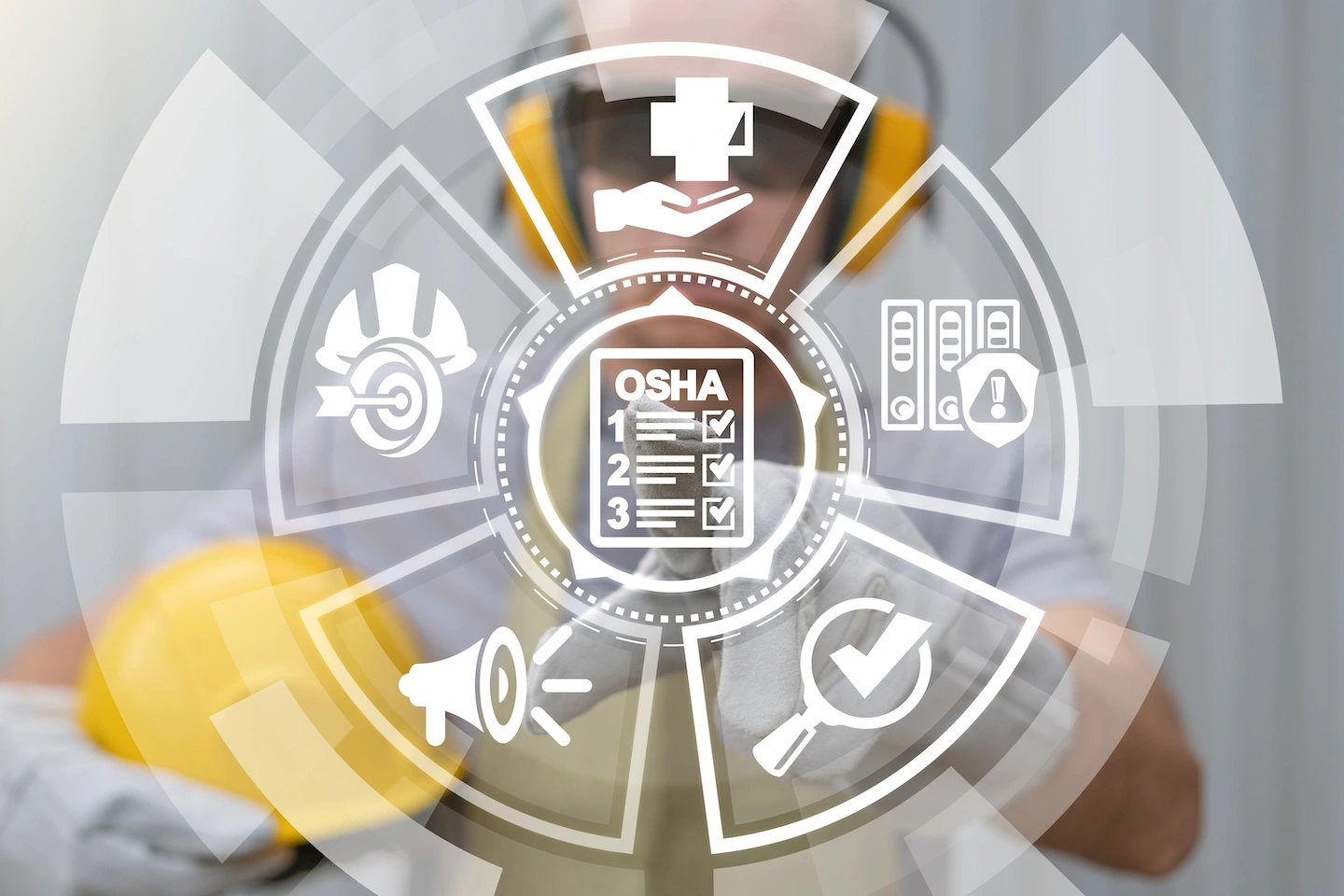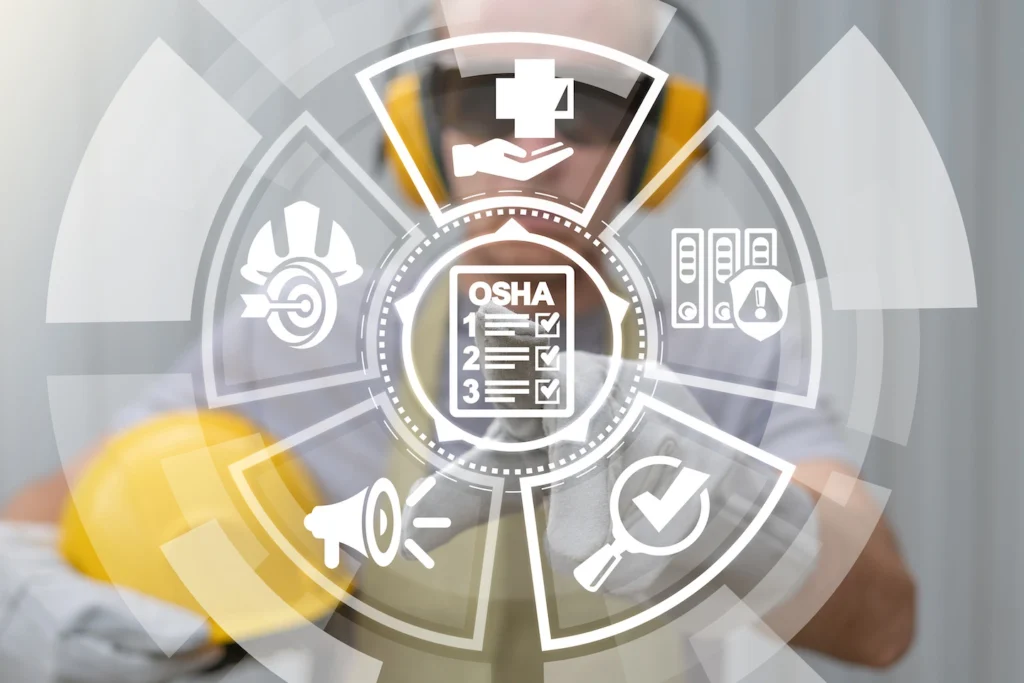In today’s dynamic work environments, safety is paramount. Employers are responsible for providing a safe and healthy workplace for their employees, and implementing effective safety programs is crucial to achieving this goal. From OSHA compliance programs to industry-specific protocols, there’s a wide array of safety initiatives available to address various hazards and risks. In this blog post, we’ll dive into the diverse landscape of safety programs, highlighting OSHA, Health Safety Environmental (HSE) Programs, and Construction Safety Programs.

OSHA Compliance Programs
The Occupational Safety and Health Administration (OSHA) sets regulations and standards to ensure workplace safety. OSHA compliance programs are designed to address specific safety concerns and meet regulatory requirements. These programs include:
- Injury and Illness Prevention Program (IIPP)
- Hazard Communication Program (HazCom)
- Respiratory Protection Program
- Lockout/Tagout (LOTO) Program
- Confined Space Entry Program
- Bloodborne Pathogens Program
- Hearing Conservation Program
- Fall Protection Program
- Electrical Safety Program
- Personal Protective Equipment (PPE) Program
- Machine Guarding Program
- Hazardous Energy Control Program
Industries Covered by OSHA Compliance
OSHA regulations apply to nearly all workplaces in the United States, with few exceptions such as self-employed individuals, family farms, and workplaces regulated by other federal agencies, such as the Nuclear Regulatory Commission and the Department of Transportation. Industries subject to OSHA compliance include, but are not limited to:
- Manufacturing
- Construction
- HVAC
- Healthcare
- Agriculture
- Retail
- Hospitality
- Transportation
- Warehousing
- Telecom
Renewal Requirements
OSHA compliance programs typically do not have specific renewal timelines mandated by OSHA itself. However, it’s essential for employers to regularly review and update their safety programs to ensure ongoing compliance with changing regulations, evolving workplace conditions, and advancements in safety practices. Renewal intervals may vary depending on factors such as:
- Regulatory changes: OSHA periodically updates its regulations and standards, necessitating revisions to existing safety programs to align with the latest requirements.
- Workplace modifications: Any significant changes in workplace operations, processes, or hazards may warrant updates to safety programs to address new risks effectively.
- Employee turnover: With turnover in personnel, training and retraining on safety protocols may be necessary to maintain compliance and ensure employee safety.
- Incident reviews: After workplace accidents or near misses, conducting thorough reviews can identify areas for improvement in safety programs, prompting updates or revisions.
Importance of OSHA Compliance
Maintaining OSHA compliance is not just a legal obligation – it’s a crucial aspect of fostering a safe and productive work environment. Non-compliance with OSHA regulations can result in severe consequences, including fines, penalties, and potential legal liabilities. Moreover, prioritizing workplace safety through OSHA compliance demonstrates a commitment to employee well-being, which can enhance morale, reduce absenteeism, and improve overall productivity.
Key Elements of OSHA Compliance Programs
OSHA compliance programs encompass various components tailored to address specific workplace hazards and regulatory requirements. Some key elements often included in OSHA compliance programs are:
- Written programs: Documented safety policies and procedures outlining measures to mitigate workplace hazards and ensure regulatory compliance.
- Employee training: Comprehensive training programs to educate employees on safety protocols, hazard recognition, and emergency procedures.
- Hazard assessments: Regular assessments of workplace hazards to identify and mitigate risks through engineering controls, administrative measures, and personal protective equipment (PPE).
- Recordkeeping: Accurate recordkeeping of safety-related incidents, training sessions, inspections, and corrective actions taken to address identified hazards.
- Regular inspections: Routine inspections of the workplace to identify potential hazards, ensure compliance with safety regulations, and implement corrective measures as needed.
- Management commitment: Leadership commitment to prioritizing workplace safety, allocating resources for safety initiatives, and fostering a culture of safety among employees.

Health Safety Environmental (HSE)
Health Safety Environmental programs focus on minimizing environmental impact and ensuring workplace safety. These programs may include:
- Emergency Response and Evacuation Plan
- Spill Response and Prevention Program
- Hazardous Waste Management Program
- Air Quality Control Program
- Water Pollution Prevention Program
- Stormwater Pollution Prevention Plan (SWPPP)
- Environmental Management System (EMS)
Industries Covered by HSE Programs
HSE programs are relevant across diverse industries where activities may impact the environment or pose risks to worker health and safety. Industries commonly requiring HSE programs include:
- Manufacturing
- Chemical processing
- Oil and gas
- Construction
- Healthcare
- Pharmaceutical
- Mining
- Transportation
- Utilities
Renewal Requirements
Unlike certifications or licenses that may have specific renewal timelines, HSE programs typically require ongoing maintenance and periodic updates to address changing regulations, emerging risks, and evolving best practices. Renewal intervals for HSE programs may vary based on factors such as:
- Regulatory changes: Updates to environmental regulations and safety standards necessitate revisions to HSE programs to ensure compliance with the latest requirements.
- Technological advancements: Advances in technology may introduce new environmental risks or enable more effective mitigation strategies, prompting updates to HSE programs.
- Environmental impact assessments: Periodic assessments of environmental impact help identify areas for improvement and inform updates to HSE programs to minimize adverse effects on the environment.
- Incident reviews: Evaluating incidents, near misses, and environmental violations provides valuable insights for enhancing HSE programs and preventing future incidents.
Importance of HSE Programs
HSE programs play a vital role in promoting sustainable business practices, safeguarding employee health and safety, and mitigating environmental liabilities. By proactively addressing environmental risks and ensuring compliance with regulations, organizations can:
- Protect the health and well-being of employees by minimizing exposure to hazardous substances and unsafe working conditions.
- Reduce the risk of environmental incidents, such as chemical spills, air emissions, and water pollution, which can lead to costly clean-up efforts, regulatory penalties, and reputational damage.
- Enhance operational efficiency and resource conservation through the adoption of environmentally sustainable practices and waste reduction initiatives.
- Demonstrate corporate responsibility and commitment to environmental stewardship, which can enhance brand reputation, attract customers, and attract and retain talent.
Key Elements of HSE Programs
HSE programs typically encompass a range of elements aimed at addressing environmental, health, and safety risks in the workplace. Some key components often included in HSE programs are:
- Environmental management systems (EMS): Frameworks for managing environmental responsibilities, assessing environmental impacts, and implementing strategies to minimize adverse effects.
- Hazardous materials management: Protocols for safely handling, storing, and disposing of hazardous substances to prevent environmental contamination and protect worker health.
- Air quality control: Measures to monitor and mitigate air emissions, such as particulate matter, volatile organic compounds (VOCs), and greenhouse gasses, to comply with air quality regulations.
- Water pollution prevention: Strategies to prevent water pollution through measures such as wastewater treatment, stormwater management, and spill prevention.
- Waste management: Practices for minimizing waste generation, recycling materials, and disposing of waste in compliance with regulatory requirements.
- Emergency response and preparedness: Plans and procedures for responding to environmental emergencies, such as chemical spills, fires, and natural disasters, to minimize risks to personnel and the environment.
- Training and education: Employee training programs to raise awareness of environmental hazards, promote safe work practices, and ensure compliance with HSE regulations.

Construction Safety Programs
Construction sites pose unique safety challenges, necessitating specialized safety programs such as:
- Construction Safety Plan
- Excavation and Trenching Safety Program
- Scaffold Safety Program
- Crane Safety Program
- Fall Protection Plan for Construction
Industries Covered by Construction Safety Programs
Construction Safety Programs are primarily applicable to the construction industry, including sectors such as:
- Residential construction
- Commercial construction
- Civil engineering projects
- Infrastructure development
- Industrial construction
Renewal Requirements
Construction Safety Programs typically do not have specific renewal timelines mandated by regulatory agencies. However, they require ongoing maintenance and periodic updates to address changes in regulations, project requirements, and emerging safety hazards. Renewal intervals may vary based on factors such as:
- Regulatory changes: Updates to construction safety regulations and standards necessitate revisions to safety programs to ensure compliance with the latest requirements.
- Project-specific considerations: Each construction project may have unique safety hazards and requirements, requiring adjustments to the safety program to address project-specific risks.
- Incident reviews: Learning from incidents, accidents, and near misses on construction sites can inform updates to safety programs to prevent similar incidents in the future.
- Technological advancements: Advances in construction technology may introduce new safety hazards or enable more effective safety measures, prompting updates to safety programs.
Importance of Construction Safety Programs
Construction Safety Programs are critical for protecting the lives and well-being of construction workers, reducing the risk of accidents and injuries, and ensuring compliance with safety regulations. By implementing comprehensive safety programs, construction companies can:
- Protect workers from hazards: Construction sites are inherently hazardous environments, with risks such as falls, electrocution, struck-by accidents, and caught-in/between hazards. Safety programs help identify and mitigate these risks to prevent accidents and injuries.
- Enhance productivity: A safe work environment fosters greater productivity by reducing downtime due to accidents, injuries, and regulatory non-compliance. When workers feel safe, they can focus on their tasks without worrying about potential hazards.
- Avoid regulatory penalties: Compliance with construction safety regulations, such as those enforced by OSHA and other regulatory agencies, helps construction companies avoid fines, penalties, and legal liabilities resulting from safety violations.
- Improve reputation: Demonstrating a commitment to construction safety not only protects workers but also enhances the reputation of construction companies. Clients, investors, and stakeholders are more likely to trust and engage with companies that prioritize safety.
- Attract and retain talent: A strong safety culture attracts skilled workers who value their well-being and seek employment with companies that prioritize safety. Additionally, construction companies with excellent safety records are better able to retain experienced workers, reducing turnover and recruitment costs.
Key Elements of Construction Safety Programs
Construction Safety Programs typically include a range of elements aimed at identifying, assessing, and controlling hazards on construction sites. Some key components often included in Construction Safety Programs are:
- Safety policies and procedures: Documented policies and procedures outlining safety protocols, hazard identification, and safe work practices on construction sites.
- Safety training: Comprehensive training programs to educate workers on construction safety regulations, hazard recognition, emergency procedures, and the proper use of personal protective equipment (PPE).
- Job hazard analysis: Systematic assessments of construction tasks to identify potential hazards and develop controls to mitigate risks.
- Site inspections: Regular inspections of construction sites to identify unsafe conditions, ensure compliance with safety regulations, and implement corrective measures.
- Fall protection: Measures to prevent falls from heights, such as guardrails, safety nets, and personal fall arrest systems (PFAS).
- Electrical safety: Protocols for safely working with electricity, including lockout/tagout procedures, electrical hazard recognition, and use of insulated tools.
- Equipment safety: Inspection, maintenance, and safe operation of construction equipment and machinery to prevent accidents and injuries.
- Emergency preparedness: Plans and procedures for responding to emergencies, such as fires, medical emergencies, and hazardous material spills, to minimize risks to workers and bystanders.
Other Types of Written Safety Programs
While OSHA, HSE, and Construction Safety Programs are more common, these only begin to scratch the surface of all the various types of safety programs that companies may be required to fulfill. Below are some additional safety programs that Cascade QMS can help you with:
Transportation Safety Programs
For organizations with transportation activities, ensuring road safety is essential. Transportation safety programs may include:
- Fleet Safety Program
- Defensive Driving Program
- Driver Fatigue Management Program
- Hazardous Materials Transportation Program
Industrial Hygiene Programs
Industrial hygiene programs focus on identifying and mitigating workplace hazards, including:
- Exposure Control Program
- Chemical Hygiene Plan
- Indoor Air Quality Program
- Heat Stress Prevention Program
Fire Safety Programs
Fire safety programs aim to prevent and respond to fire-related emergencies, encompassing:
- Fire Prevention Plan
- Fire Emergency Response Plan
- Hot Work Permit Program
- Workplace Violence Prevention Program
Injury and Illness Management Programs
Managing workplace injuries and illnesses involves programs such as:
- Return-to-Work Program
- Recordkeeping and Reporting Program
- Process Safety Management (PSM) Program
Employee Wellness Programs
Employee wellness programs promote physical and mental well-being, including initiatives like:
- Health and Fitness Programs
- Stress Management Programs
- Ergonomics Program
Additional Safety Programs
Beyond the aforementioned categories, there are numerous other safety programs addressing specific risks and compliance needs, such as:
- Arc Flash Hazard Analysis
- Radiation Safety Program
- Biological Safety Program
- Pest Control Program
- Traffic Control Safety Program

Cascade QMS: Your Trusted Partner in Quality Management Systems
Safety is a multifaceted endeavor, and implementing appropriate safety programs is essential for safeguarding employees and maintaining regulatory compliance. While this list provides a comprehensive overview, it’s important to tailor safety programs to the unique needs of each organization.
Cascade QMS stands as a trusted partner for achieving all necessary safety programs and compliance requirements. With customized solutions tailored to contractors and suppliers across every industry globally, Cascade QMS offers Health Safety Environmental (HSE) manuals, ISNetworld® Management Plans, employee training, and more.
With 40 years of certifiable success, Cascade QMS is committed to streamlining processes, enhancing quality, and ensuring employee safety, making us your trusted resource in achieving compliance and safety goals. Contact us today to get started!

